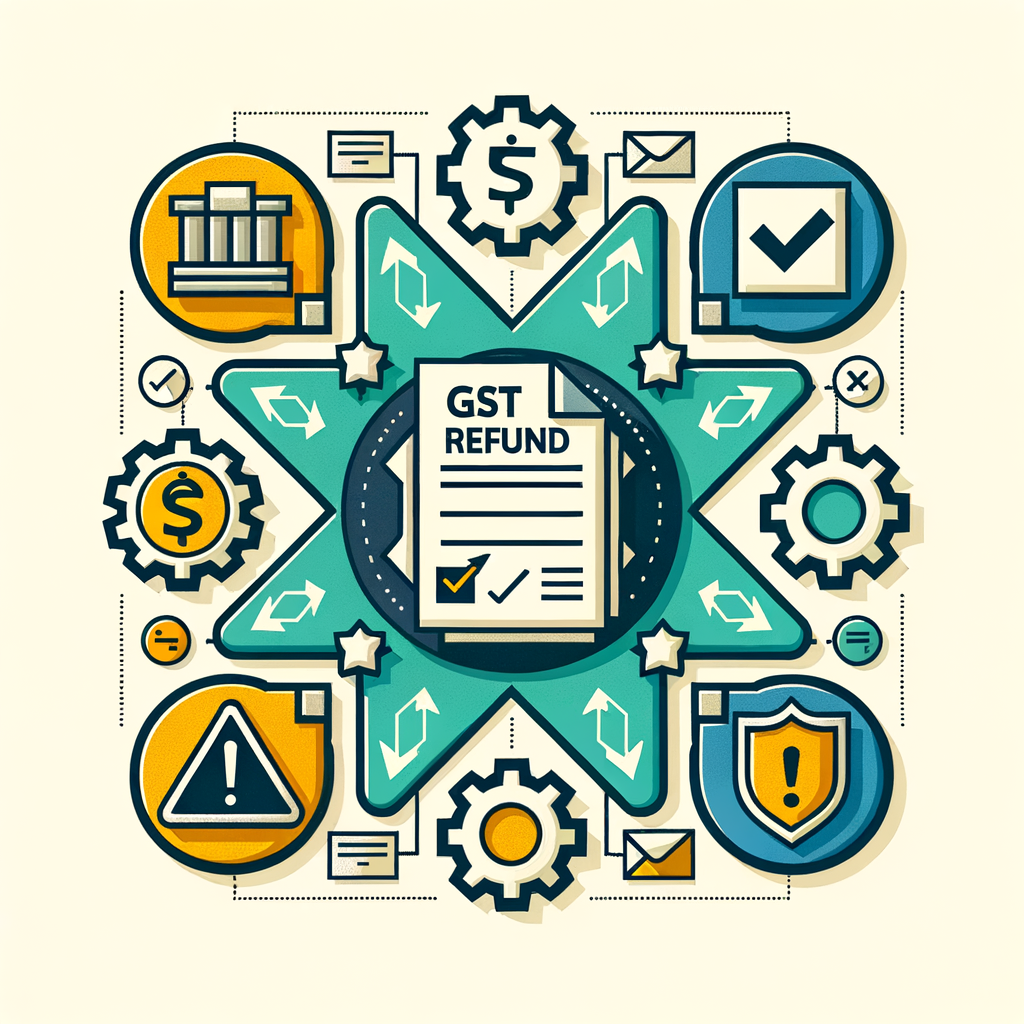GST Refund Process: Steps, Challenges, and Best Practices for Indian Businesses
Is your hard-earned money stuck in the GST system? For any small business in India, unlocking working capital is crucial for survival and growth, but navigating the tax system can often feel like a hurdle. Understanding the GST refund process is not just a compliance task; it’s a vital financial strategy to maintain healthy cash flow and keep your business running smoothly. When you pay more Goods and Services Tax (GST) than you are liable for, the government provides a mechanism to claim it back. This guide is designed to demystify this procedure, providing you with a clear, step-by-step roadmap on how to claim GST refund in India, overcome common challenges, and implement best practices for a hassle-free experience.
Understanding When You Can Claim a GST Refund
Before diving into the procedural steps, it’s essential to understand the fundamental grounds on which a business becomes eligible to claim a refund. Not every excess payment qualifies, and knowing the specific scenarios recognized by the law is the first step towards a successful claim. This knowledge ensures that you apply under the correct category with the right documentation, significantly increasing your chances of a swift approval and preventing unnecessary rejections that could further block your funds.
What is a GST Refund?
A GST refund is the process of receiving back any excess GST paid to the government. This situation arises when the GST paid by a business (on purchases, known as Input Tax) is more than its GST liability (on sales, known as Output Tax). The Indian GST framework is composed of Central GST (CGST), State GST (SGST), and Integrated GST (IGST). The core principle behind the refund mechanism is the concept of Input Tax Credit (ITC), which allows businesses to deduct the tax they’ve already paid on inputs from the tax they need to pay on their final output. When this ITC accumulates and cannot be utilized against output tax liability, or when taxes are paid erroneously, it creates a situation where the business is entitled to a refund, ensuring that taxes do not become a cost for the business and the fundamental principle of taxing only the final consumption is upheld.
Top 5 Scenarios for Claiming a GST Refund
While there are several situations where a refund can be claimed, some are more common for businesses in India. Understanding these primary scenarios helps you identify if your business qualifies for a refund claim.
- 1. Zero-rated Supplies: This is one of the most frequent reasons for refund claims. It includes the export of goods or services out of India and supplies made to a Special Economic Zone (SEZ) developer or unit. Since exports are not taxed under GST to make Indian goods more competitive globally, businesses can claim a refund on the ITC accumulated on inputs used to make these supplies.
- 2. Inverted Duty Structure: This complex-sounding term has a simple meaning: the tax rate on your raw materials (inputs) is higher than the tax rate on your finished products (output supplies). For example, if you manufacture a product where the inputs are taxed at 18% but the final product is taxed at 5%, you will consistently accumulate unused ITC. The GST law allows you to claim a refund for this unutilized credit.
- 3. Excess Balance in Electronic Cash Ledger: Sometimes, businesses mistakenly deposit more money into their Electronic Cash Ledger than required for their tax liability. This could be due to a calculation error or an accidental double payment. In such cases, you can claim a refund of the excess amount lying in your cash ledger.
- 4. Deemed Exports: The government notifies certain transactions as “deemed exports.” These are not actual physical exports but are treated as such for GST purposes to provide a boost to domestic manufacturing. Supplies to Export Oriented Units (EOUs) or against an Advance Authorisation license are common examples. The supplier can claim a refund on the tax paid for these deemed export supplies.
- 5. Refund for Embassies or UN Bodies: Foreign embassies, diplomatic missions, and specified UN bodies are not liable to pay Indian taxes. They first pay the GST on their purchases of goods and services in India and then claim a refund of the tax paid based on a Unique Identity Number (UIN) issued to them.
The Complete GST Refund Process Steps in India (Online)
The government has streamlined the refund mechanism by making it entirely online, ensuring transparency and reducing manual intervention. Following the correct GST refund process steps India is critical for a smooth and timely claim settlement. The entire journey, from application to disbursement, happens on the official GST Portal.
Step 1: Login and Prepare Your Application (Form GST RFD-01)
The first step is to gather all your documents and file the application form. Accuracy at this stage is paramount.
- Begin by logging into the official GST Portal.
- Once logged in, navigate through the dashboard: Services > Refunds > Application for Refund.
- You will be prompted to select the reason for your refund (e.g., Export of Goods, Inverted Duty Structure).
- The system will then display Form GST RFD-01. You must fill this form with meticulous care, providing details about the tax period, the refund amount claimed under CGST, SGST/UTGST, and IGST, and your bank account details for the credit.
- The most critical part is uploading the necessary supporting documents. This can include tax invoices, shipping bills or bills of export, Bank Realisation Certificates (BRCs) or Foreign Inward Remittance Certificates (FIRCs), and a declaration or undertaking, depending on the nature of your claim.
Step 2: ARN Generation and Initial Acknowledgment
Once you have filled out the form and uploaded all the necessary documents, you need to submit it using your Digital Signature Certificate (DSC) or Electronic Verification Code (EVC).
- Upon successful filing of Form GST RFD-01, an Application Reference Number (ARN) will be generated and sent to your registered email address and mobile number. This ARN is your unique tracking ID for the entire refund process.
- The application and the accompanying documents are then forwarded electronically to the jurisdictional tax officer.
- If the application is found to be complete in all respects, the officer will issue an acknowledgment in Form GST RFD-02 within 15 days of your application date. This date is crucial as the 60-day timeline for processing your refund begins from here.
Step 3: Scrutiny by the Tax Officer
After acknowledgment, your application undergoes a detailed verification by the designated tax officer. The officer will check the validity of your claim and the authenticity of the documents you have submitted.
- The officer will scrutinize the application for any errors, inconsistencies, or mismatches between your refund claim and the data reported in your GST returns (GSTR-1 and GSTR-3B).
- If the officer finds any discrepancies or requires further clarification or documentation, they will issue a Deficiency Memo in Form GST RFD-03. You will then need to rectify the errors and file a fresh refund application. It is important to note that a deficiency memo is not a rejection; it is an opportunity to correct your application.
Step 4: Final Sanction and Payment
This is the final stage where your claim is either approved or rejected.
- For claims related to zero-rated supplies, the officer may sanction up to 90% of the claimed amount as a provisional refund within 7 days of acknowledgment. This is done through Form GST RFD-04 to help exporters with their working capital.
- After thorough verification, if the officer is satisfied with the claim, they will pass a final sanction order in Form GST RFD-06.
- Simultaneously, a payment advice will be issued in Form GST RFD-05, and the sanctioned refund amount will be credited directly to the bank account you provided in your registration details.
- As per GST refund guidelines for Indian businesses, the entire process, from the date of filing a complete application (i.e., when RFD-02 is issued), should be completed within 60 days.
Navigating the Common Challenges in GST Refund India
While the online system has improved efficiency, many businesses still face hurdles. Being aware of the common challenges in GST refund India can help you prepare better and avoid potential pitfalls that could lead to delays or rejections.
Documentation Mismatches
One of the most frequent reasons for receiving a deficiency memo or a rejection notice is a mismatch in the data provided.
- Problem: Discrepancies between the details declared in your GSTR-1 (sales data), GSTR-3B (summary return), and the information on supporting documents like shipping bills or tax invoices are a major red flag for tax officers. For instance, the invoice number or taxable value mentioned in the refund application might not match what was declared in your GSTR-1 for that period.
- Solution: The key to avoiding this is rigorous monthly reconciliation. Before filing any return or refund application, ensure that your internal accounting records, GSTR-1, GSTR-3B, and GSTR-2A/2B are all in perfect sync. Using reliable accounting software that integrates with the GST system can automate this process and minimize human error.
Procedural Delays and System Glitches
Despite the stipulated 60-day timeline, many businesses experience significant delays in receiving their refunds.
- Problem: Sometimes, applications get stuck in the system without any communication from the department. Technical glitches on the GST Portal during peak filing times can also lead to errors in submission or failure to upload documents correctly. These delays can severely impact a business’s working capital cycle.
- Solution: Proactive tracking is essential. Regularly check the status of your application on the GST Portal using your ARN. If there is no movement or communication after a reasonable period, do not hesitate to make a formal follow-up with the jurisdictional GST officer. Maintaining a clear record of all communications can be helpful if you need to escalate the issue.
Incorrect Information in Refund Application
Simple clerical errors are another common yet easily avoidable cause for refund application issues.
- Problem: Submitting an application with incorrect details, such as a wrong bank account number, selecting the incorrect tax period, or making a calculation error in the refund amount, can lead to immediate rejection or a deficiency memo. Since a fresh application is required after a deficiency memo, this restarts the entire process.
- Solution: The solution is simple: double-check everything before you click submit. Review every field in Form RFD-01, verify the bank account details registered on the portal, and ensure the tax period aligns with the documents you are submitting. A second pair of eyes reviewing the application before final submission is always a good practice.
Best Practices for a Smooth GST Refund
To ensure your refund is processed quickly and without any hitches, adopting a disciplined and systematic approach is crucial. Following these best practices for GST refund will not only increase your success rate but also make the entire compliance process more efficient.
Maintain Meticulous and Organized Records
Proper documentation is the backbone of a successful refund claim. The tax officer’s decision is based entirely on the evidence you provide.
- Create a robust system for record-keeping. Maintain separate digital and physical files for all tax invoices, e-way bills, shipping bills, bills of lading, Bank Realisation Certificates (BRCs), and any other documents related to your supplies.
- Ensure every document is complete, legible, and easily accessible. When you need to file a refund, having everything organized will save you immense time and stress.
Timely Filing of All GST Returns
This is a non-negotiable prerequisite. The GST system is interconnected, and your eligibility for a refund is directly linked to your overall compliance history.
- Filing your GSTR-1 and GSTR-3B accurately and on time every month is fundamental. The GST Portal will not even allow you to file a refund application for a period for which you haven’t filed these basic returns.
- Any delay or error in your regular returns will have a cascading effect, creating mismatches and delaying your refund claim.
Regular Reconciliation of Data
As mentioned earlier, reconciliation is not a one-time activity but a continuous process that should be part of your monthly accounting cycle.
- Before filing your GSTR-3B, always reconcile your purchase data with GSTR-2A and GSTR-2B to ensure you are claiming the correct Input Tax Credit.
- Similarly, reconcile your sales register with the data you upload in GSTR-1. This practice ensures that the data forming the basis of your refund claim is accurate and has already been reported correctly to the tax department, leaving no room for discrepancies.
Seek Professional Guidance
While the process is online, the nuances of GST law, especially for complex cases, can be challenging to navigate.
- For intricate refund claims, such as those under the inverted duty structure or involving multiple export transactions, small errors can lead to large financial implications.
- Consulting a tax expert or a CA can be a wise investment. Professionals are well-versed with the latest GST refund guidelines for Indian businesses and can help you prepare a flawless application, manage documentation, and handle departmental queries effectively, saving you both time and money in the long run.
Conclusion
A well-managed GST refund process is a powerful tool for optimizing your business’s financial health. By understanding the eligibility criteria, meticulously following the online application steps, and proactively addressing potential challenges, you can ensure that your legitimate claims are processed swiftly, releasing valuable working capital back into your business. The foundation of a successful refund claim lies in accuracy, timely filing of returns, and impeccable documentation. While the system is designed to be straightforward, diligence is key to navigating it successfully. Remember, a smooth refund process is not just about getting your money back; it’s about maintaining a compliant and financially robust business.
Navigating the GST refund process can be complex. If you need expert assistance to ensure your claim is filed correctly and processed quickly, the specialists at TaxRobo are here to help. Contact us today to streamline your GST compliance!
Frequently Asked Questions (FAQs)
Q1. What is the time limit for claiming a GST refund?
A: A refund application must be filed within two years from the “relevant date.” This relevant date varies depending on the reason for the refund. For example, in the case of the export of goods, the relevant date is the date on which the ship or aircraft leaves India. For services, it’s typically the date of receipt of payment in convertible foreign exchange.
Q2. Do I get interest if my GST refund is delayed?
A: Yes, if the refund amount is not paid within 60 days from the date of receipt of a complete application (i.e., the date of acknowledgment in RFD-02), you are entitled to receive interest. The current rate of interest is 6% per annum, calculated for the period of delay beyond the 60-day limit.
Q3. Can I file a manual GST refund application?
A: No, the entire GST refund process is digital. All applications for a GST refund must be filed online through the official GST Portal using the prescribed form, which is GST RFD-01. Manual applications are not accepted.
Q4. What is a Deficiency Memo (Form GST RFD-03)?
A: A Deficiency Memo is a communication issued by the tax officer if your refund application is found to be incomplete or has errors (e.g., missing documents, data mismatches). It is not a rejection of your claim. Upon receiving RFD-03, you must rectify the deficiencies mentioned in the memo and file a fresh, corrected refund application.



